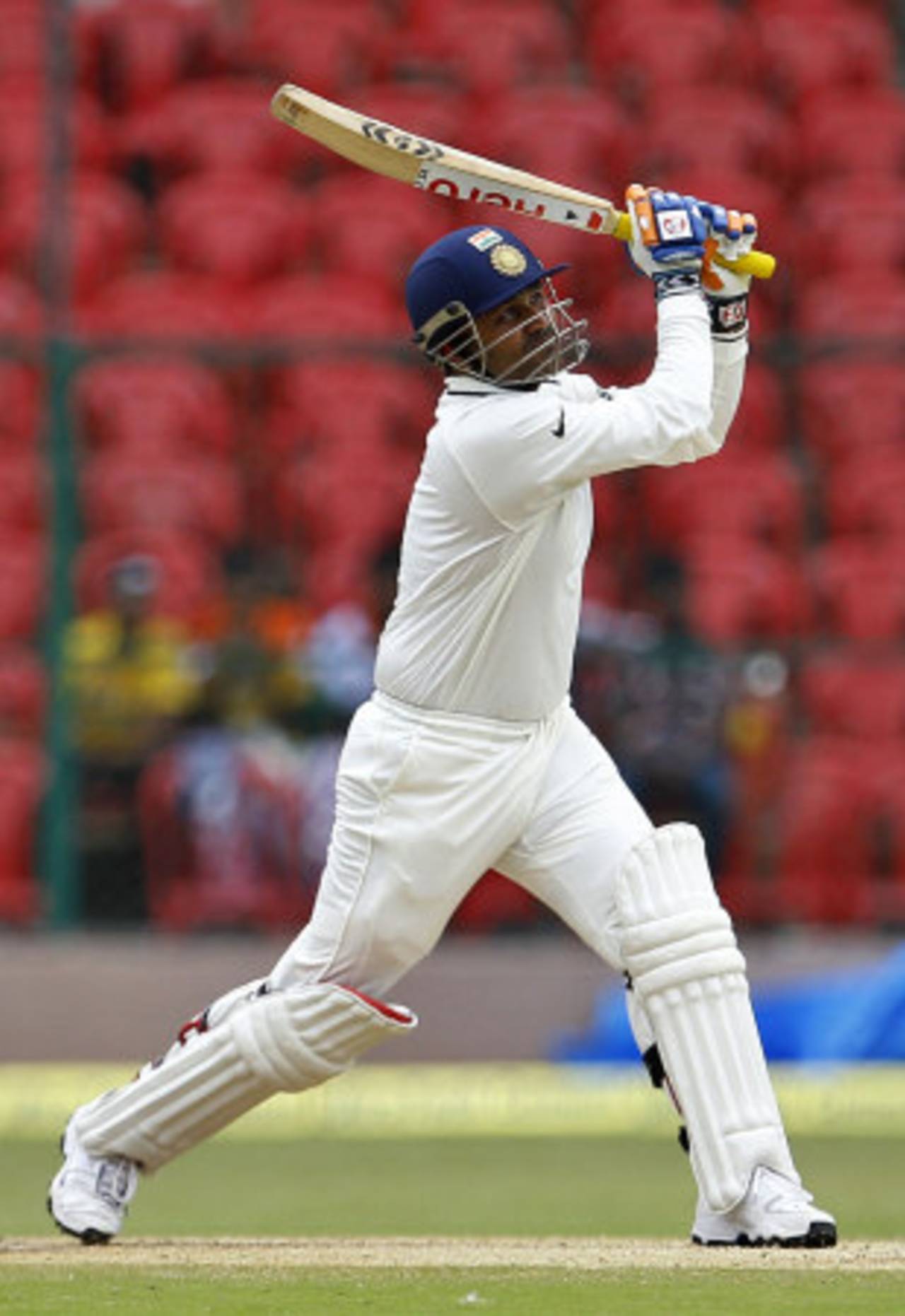Sehwag must resist middle-order temptation
His request to move down the order may not necessarily be beneficial for him or the team
Ian Chappell
22-Sep-2013

Much of Virender Sehwag's aura as a batsman is bound up in his aggressive approach, which a move down the order would probably diminish • Associated Press
Despite his early history as a middle-order batsman, Virender Sehwag's request to finish his career there, rather than opening, may not necessarily be beneficial for him or the team.
For starters, Sehwag is ignoring his own advice. He once told the dashing young Australian opener David Warner he would eventually become a better Test player than a T20 batsman. Warner, playing for the aptly named Delhi Daredevils, seemed surprised at the suggestion and asked for his reasoning. "Because," replied Sehwag, "in a Test match the field is 'up' for the new ball and there are plenty of gaps to hit through."
That situation also means there are fewer infielders in position to take catches, and for a player like Sehwag, who hits the ball in the air regularly, that's a major consideration.
Then there's the not-so-minor matter of Sehwag setting the pattern of play at the top of the order. When you come in lower down, the rhythm of the innings is already established, and with a few wickets down, a batsman's approach may need to alter. He no longer starts on an equal footing with the bowlers.
Take the way Sehwag plays spinners, for example. In the past he has shown little respect for spinners and, upon their introduction, he has set about trying to drive them into oblivion via the farthest reaches of the grandstand. As an opener, when he has already pummelled the faster bowlers for a quick-fire 60 and got the team off to a flying start, Sehwag is afforded some leniency when he then holes out in the deep.
However, when Sehwag is dismissed in the middle order for a low score and sets off a batting collapse by attempting an outlandish onslaught on a spinner, it's likely to test the selectors' patience.
Sehwag will have to take these and other matters, like having to wait to bat, into account if he returns to the middle order. Nevertheless, the most important aspect of any experienced player looking to slide down the order is his mental state; such a request is generally an admission the player is starting to have misgivings.
Ricky Ponting made that mistake late in his career and his move was only minor, going from No. 3 to No. 4. Nevertheless, it was a major move mentally and sent a signal to the opposition that Ponting, for so long a dominant batsman, was feeling vulnerable.
The most important aspect of any experienced player looking to slide down the order is his mental state; such a request is generally an admission the player is starting to have misgivings
Like for Ponting, much of Sehwag's aura as a batsman is bound up in his aggressive approach to the bowling. Once that is diminished with a move down the order it's like being a wounded animal; the predators smell blood.
Sachin Tendulkar, on the other hand, has never wavered; he has batted at No. 4 for the bulk of his career and has remained resolute in not moving lower down the order. In his mind he's a No. 4 and that's the way he wants to finish his career.
Part of being a long-term Test player is knowing where you want to bat. The captain may not always see things the same way, but a batsman must be clear in his own mind what position he thinks suits him best. The Australian selectors of the time had the misguided idea that I should open, and skipper Bill Lawry asked me for my thoughts. I replied: "Bill, you're the captain and if you tell me I'm opening then I'll do it, but if you're asking for my preference then it's to bat at three." In my mind I was a No. 3 and I wanted to remain in that position until I retired.
There have been suggestions that India will need some experience in the middle order when Tendulkar retires, and that Sehwag may provide the answer. India already have plenty of talent and not inconsiderable experience in Murali Vijay, Shikhar Dhawan, Cheteshwar Pujara and Virat Kohli.
That makes a strong top four when Tendulkar decides to retire. To then replace a middle-order player in his 40s with one in his mid-30s, who is struggling as an opener, doesn't sound like a progressive move.
Former Australia captain Ian Chappell is now a cricket commentator for Channel 9, and a columnist